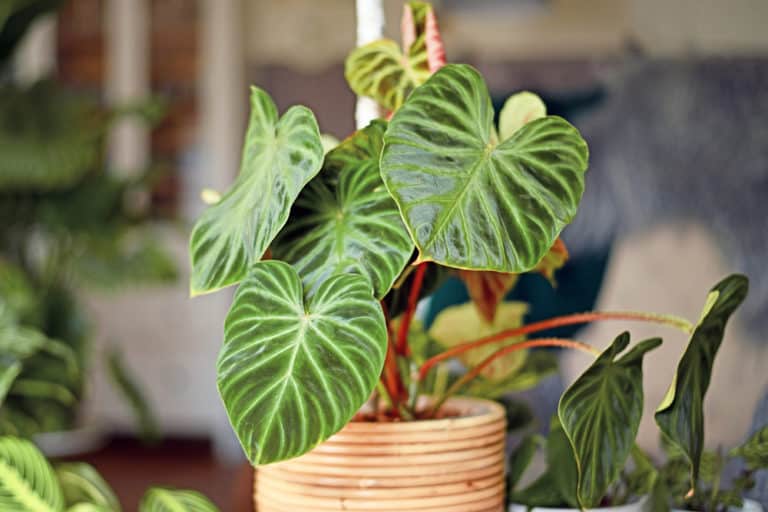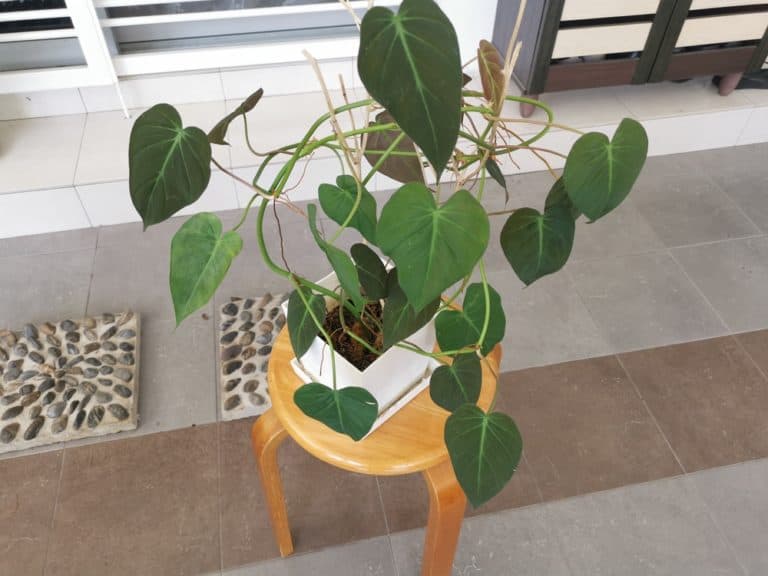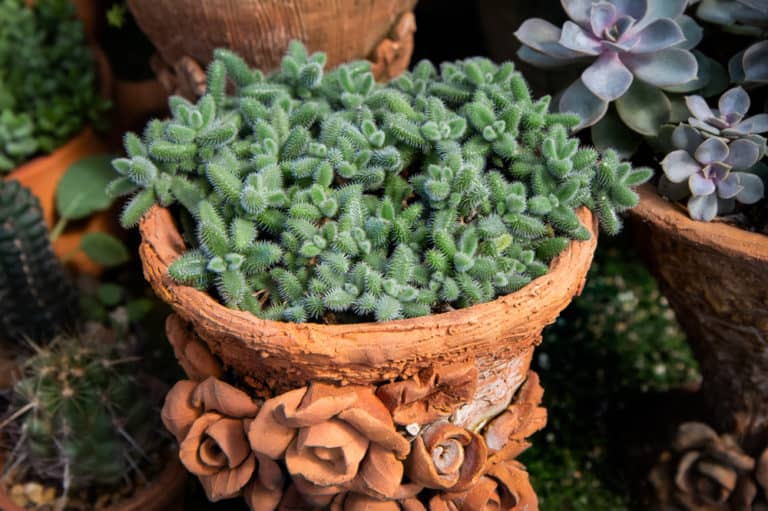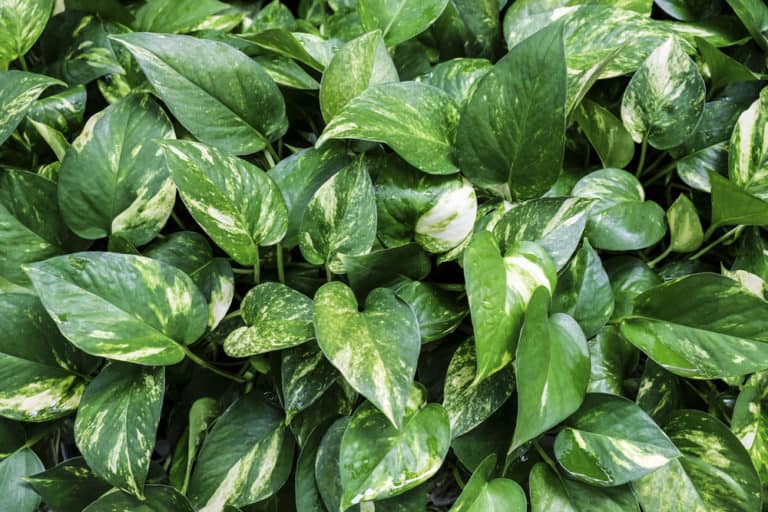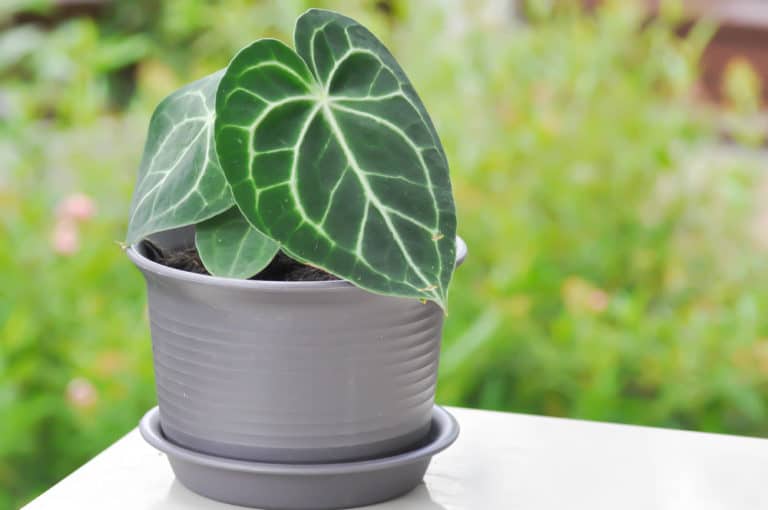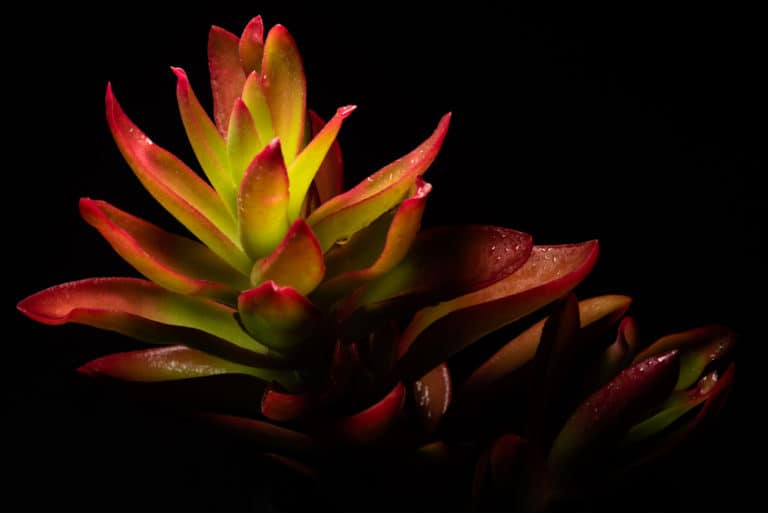Monstera Karstenianum ‘Peru’ Care Guide (2024)

Monstera Peru is a beautiful plant to grow in your indoor garden, no matter how small.
While Monstera karstenianum’s vines can stretch 8 feet when grown inside, its climbing and trailing growth habit lets you tuck it into empty nooks and crannies.
As well, it’s easy to grow, even for first-time gardeners.
| Scientific Name | Monstera karstenianum |
| Common Name | Monstera Peru |
| Light | Bright indirect sunlight |
| Watering | Water if the top inch of soil is dry |
| Temperature | 60 to 85ºF (16 to 30ºC) |
| Hardiness Zone | 10b, 11a, 11b, 12a, 12b |
| Humidity | 50 to 70% |
| Soil Type | Rich, quick-draining, loamy |
| Soil pH | 5 to 7.5 (acidic to neutral) |
| Fertilizing | A balanced feed once a month in spring and summer |
| Repotting | Every 2 years |
| Pruning | Spring and summer |
| Propagation | Root in water or soil |
| Toxicity | Toxic to humans and pets |
| Mature Size | 6 to 8 feet as a houseplant |
| Bloom Time | Rarely flowers indoors |
What’s Unique About Monstera Peru?
Oddly enough, the Monstera Peru plant may not be either a Monstera or from Peru! The origins of this hot new houseplant are a mystery.
It does not yet have a scientifically accepted name, but most people call it Monstera karstenianum. However, it may actually be a philodendron native to Venezuela.
Still, the growing conditions are pretty well the same for both.
Monstera Peru plants are prized for their beautiful leaves, with a unique texture.
Growing Monstera Peru is not complicated, even if you’ve never had a houseplant before.
As well, it’s a natural air purifier, filtering out harmful contaminants from your indoor environment.
Monstera Peru Care
In the tropical rainforests where Monstera Peru originates, it grows in the shady understory of the towering tree canopy, thriving in its hot, humid environment.
Monstera Peru plant care should reflect those origins.
For good Monstera karstenianum care, keep your plant warm and out of the full sun while providing it with the moist soil and air it craves.
Light
Monstera Peru evolved in the shade of tall trees which filter the bright rays from the tropical sun.
As a result, Monstera Peru light requirements are for bright but indirect light. About 10,000 lux would be ideal.
You can meet your Monstera karstenianum light needs best by keeping your plant in a north or east-facing window, where they only get direct sun first thing in the day.
Monstera Peru will not tolerate full sun at all, which will damage the leaves.
In a south or west exposure, keep it back from the window or shade it with a curtain.
Watering
Instead of keeping to a regular weekly schedule, you should water Monstera karstenianum whenever the top inch or two of the soil has dried out.
Monstera Peru watering needs are for moist soil, without ever being sopping wet. The roots need to be able to breathe, so it can’t be waterlogged.
For the best Monstera Peru watering, slowly pour the water over the whole surface, stopping when water starts to come out the bottom.
It’s best to use distilled or rainwater, as the chemicals in tap water can be bad for your Monstera Peru.
However, if you have no option, let the water sit out overnight to gas off the fluoride and chlorine.
Temperature
There’s a pretty wide acceptable Monstera Peru temperature range, from 60 to 85ºF (16 to 30ºC).
Warmer is best, but you should be able to provide a good enough temperature for Monstera karstenianum in any indoor setting.
Just make sure that your Monstera Peru is kept out of drafts and away from windows in the cold winter weather, as it does not have much temperature tolerance below 50ºF (10ºC).
It will become dormant and can suffer long-term damage.
Like any tropical plant, it has no frost hardiness.
If you take your Monstera Peru outdoors in the hot summer weather, bring it in as temperatures start to drop.
Humidity
It’s pretty steamy in a tropical rainforest, so the ideal humidity for Monstera karstenianum is high, ranging as high as 70% or more.
However, Monstera Peru will usually be just fine with a humidity level between 40 to 50%.
Still, if you see the leaves starting to curl, or turning brown at the tip, you need to do more to address the Monstera Peru humidity requirements.
If you set your Monstera Peru pot on a pebbled tray and fill it with water, the extra moisture will fill the air.
However, if you have several tropical plants, the easiest thing to do is to group them together and set a small humidifier in their midst.
Soil
Monstera Peru soil should be loose and well-draining, with lots of organic matter.
Aim for a pH level for Monstera karstenianum of 5 to 7.5, or acidic to neutral.
You can make your own soil mix for your Monstera Peru by combining peat moss, perlite, and bark pieces.
Another good soil for Monstera karstenianum is a standard indoor potting mix with lots of peat and perlite mixed in.
Just make sure that it will not get compacted. It never hurts to throw in a couple of handfuls of orchid bark to ensure that it stays light and airy.
Fertilizer
It’s a good idea to use fertilizer for Monstera karstenianum to encourage the healthy growth of the leaves.
A fertilizer ratio of 10-10-10, or 5-2-3, will best suit the nutrient needs of Monstera Peru.
Use a standard indoor liquid formula for your Monstera Peru fertilizer.
Dilute it to half the recommended strength and use it once a month in spring and summer, right after you’ve watered. Pour it slowly over the soil surface.
Another nutrient that Monstera Peru sometimes requires extra of is magnesium, which encourages chlorophyll production.
Just dissolve 2 tablespoons of epsom salts in a gallon of warm water, and use that to water your Monstera Peru once a month.
Potting & Repotting
Repotting Monstera karstenianum should be done every 2 years or so, but if it becomes rootbound before that, it’s time for Monstera Peru repotting.
You will know when it’s ready when you see roots growing out the drainage holes, or when water runs right through when you water.
You may be tempted to go for a much bigger pot size, but you won’t be doing your Monstera Peru any favors. Going up by more than one pot size, or a couple of inches across, can actually hinder its growth.
Choose a pot with good drainage. Unglazed clay will help keep the soil from staying too soggy.
Always use fresh potting soil.
Pruning
Because Monstera Peru is fast-growing, you will need to do some pruning to keep it looking tidy.
Even if you have your Monstera Peru growing up a moss pole, you will want to keep its growth looking its best.
Monstera Peru pruning can be done a few times a year, but preferably in its active growing period in spring and summer.
Of course, you should trim all dead or yellowing leaves whenever they occur.
When cutting Monstera karstenianum, always cut just above a node to encourage new growth for a bushier appearance.
If necessary, you can cut back your Monstera Peru severely. It will bounce back with new, vigorous growth.
Propagation
Monstera Peru propagation is usually done from stem cuttings rooted in water or soil. The best time of the year is spring.
To propagate Monstera karstenianum in water, start by selecting healthy stems with at least a couple of nodes, and 2 or 3 leaves.
Cut the stem right below a node, and then put it directly into a jar of water. Change the water every few days, and keep it out of the direct sun in a warm, humid spot.
You can also put the cuttings into moist soil or sphagnum moss to root.
Within a month you should have a rooted Monstera Peru cutting that can be planted in a small pot.
Also, make sure to check out our in-depth Monstera pinnatipartita plant care guide.
Common Problems of Monstera Peru
There really aren’t a lot of Monstera Peru problems to worry about.
Most problems with Monstera karstenianum are caused by neglect or improper watering, so you should be able to solve them pretty easily.
Basically, if the leaves of your Monstera Peru look good, everything is going just as it should.
Pests
It’s easier to prevent Monstera Peru pests from arriving in the first place, rather than clean the bugs out after they’ve done some damage.
You should be wiping down your Monstera karstenianum leaves once a month anyway. So if you add some neem oil or insecticidal soap to the damp cloth you’re using, that will repel any insects that come around.
Spider mites leave yellow spots that turn brown, and sometimes their tell-tale webbing. Give your Monstera Peru a good spray-down in the shower or sink.
Scale insects look like brown bumps on the stems and underside of the leaves. Scrape them off and wipe down with rubbing alcohol.
Mealybugs form white masses under the leaves. Use a cotton ball soaked in rubbing alcohol to wipe them off.
Diseases
There are very few Monstera Peru diseases to concern the home grower. That’s one of the great things about growing Monstera karstenianum.
However, root rot is one disease that you should definitely keep an eye out for.
This fungal disease can develop when the soil is soaking wet, rather than just moist.
If the leaves start to turn yellow, and the stems seem mushy, pull the roots out of their pot, and shake off as much soil as you can.
If some of them are turning black, and there’s a bad smell, you have root rot.
Cut off all the affected parts, and after dusting the roots with fungicide, replant it in fresh soil after disinfecting the pot.
Growing Problems
Some growing problems are simply a result of less than optimal growing conditions.
Luckily, you can usually restore a sick plant to full health by improving its environment.
Scorched, brown leaves that look burnt are, in fact, burnt by the bright sun. Move your Monstera Peru to a shadier spot and cut off the damaged leaves.
On the other hand, dropping leaves probably means your Monstera Peru needs more sun.
Dry, yellow leaves or brown tips are a sign that your Monstera Peru isn’t getting enough humidity.
If your Monstera Peru’s leaves are curling, it needs to be watered. Give it a good soaking to restore the soil moisture levels.
Toxicity of Monstera Peru
Monstera Peru is toxic to humans and animals.
Like all members of the araceae family, the toxicity of Monstera karstenianum is caused by the calcium oxalate crystals in all parts of the plant.
The tiny, sharp crystals can damage delicate tissues when ingested, and the sap can irritate the skin.
For Humans
Monstera Peru is toxic to humans.
Adults are highly unlikely to try eating the foliage, but children can’t be counted on to do the sensible thing.
If they only try a tiny nibble, you should be able to treat the reaction at home.
Wipe all plant material from outside and inside their mouth, and give them something cold to soothe the pain.
However, a swollen tongue or difficulty breathing indicates a more serious problem, and you should take them to the emergency room immediately.
If you get some of the sap on your skin, rinse it off immediately to lessen the chances of a rash developing.
For Pets
Pets can have a more serious reaction to eating some of your Monstera Peru. They may get permanent organ damage.
If your cat, dog, or rabbit starts drooling excessively, wheezing, vomiting, or has diarrhea, you should take it to the veterinarian as soon as possible.
It’s best to keep your Monstera Peru well out of reach of the small members of the household to prevent such an emergency.
Since it’s very happy growing as a trailing plant, planting it in a hanging basket is a great solution. Just make sure that you keep the stems trimmed several feet above floor level.
Monstera Peru Appearance
Monstera Peru is a vigorous tropical vine that will reach its full size in just a few years.
Its lustrous evergreen leaves will provide year-round foliage in your home.
You will find the Monstera Peru appearance to be lush and fresh, whether it’s climbing up a moss pole or trailing out of a hanging basket.
Foliage
The foliage of Monstera Peru is its most outstanding characteristic, and the reason it’s so prized by growers.
Unlike with most Monstera plants, Monstera Peru leaves do not change their appearance as they mature.
Each leaf unfurls at the tip of a petiole, spaced about 2 inches apart along the vine. They grow to about 2 to 4 inches long, with an oval, slightly pointed shape.
The leaves have a thick, leathery texture, with deep puckers.
They are a bright, glossy green, with darker green veins.
You will definitely want to wipe down these beautiful leaves once a month to keep them looking their best.
Flowering
Monstera Peru flowering is basically not going to happen when growing this tropical native as a potted houseplant.
Monstera Peru vines planted outdoors in tropical regions are capable of blooming. They grow much larger and so are more likely to reach the maturity necessary to bloom.
When they do bloom, the Monstera karstenianum flower is small and white, and certainly not as spectacular as the glossy green leaves that are the reason for growing Monstera Peru.
On the whole, it’s not worth even trying to get your indoor Monstera Peru to bloom; rather, focus on the growth of lush and healthy leaves.
Size and Growth
The mature size of Monstera Peru depends on how ideal its growing conditions are.
The average indoor potted plant will reach a length (or height) of 6 to 8 feet, but if you’ve got the room, it might get as long as 12 feet.
It has a fairly rapid growth rate, growing as much as 2 feet in a growing season.
Its natural inclination is to climb, so giving it a sphagnum moss pole to attach itself to is a good way to ensure strong vertical growth.
It can also be planted in a hanging basket so that its stems can trail downward.
Monstera Peru Fragrance
There is no Monstera Peru fragrance. The foliage has no discernable scent, and Monstera Peru almost never flowers indoors.
On the other hand, the Monstera Peru plant has some very positive benefits for your indoor environment.
This tropical vine has the ability to filter harmful chemicals like formaldehyde and benzene from the air, which makes it very useful indeed.
Both of these qualities can be definite advantages in a small, enclosed space like a city studio apartment or residence room.
A strongly scented plant could be overwhelming for some people, especially if they have an allergy or sensitivity to certain scents.
Suggested Uses for Monstera Peru
Indoors or outside, Monstera Peru has a lot of design possibilities.
It’s a great plant to use in a bathroom, where it can be planted in a hanging basket and enjoy soaking up all the extra humidity from your morning shower.
You can also place one in your bedroom to improve the air quality as you sleep.
In a one-room apartment, training a Monstera Peru across a trellis can give you a living screen to section off a sleeping alcove or home office.
If you live in a tropical zone, you can plant it outside and let the vines climb through the trees as they do in the wild.
FAQ
What is Monstera Peru?
Monstera Peru, or Monstera karstenianum, is an evergreen tropical vine that is native to the tropical rainforests of South America. It is usually grown as a houseplant.
How to identify Monstera Peru?
Monstera Peru has 4 inch long oval, leathery, glossy green leaves with a puckered texture. It is a vining plant that can climb or trail.
How to care for Monstera Peru?
Monstera Peru should be grown in bright, indirect sun, in a warm, humid environment, planted in soil that is kept moist and fertilized monthly during the growing season.
How to grow Monstera Peru indoors?
Monstera Peru can be grown indoors in either a hanging basket or a pot on a high shelf and allowed to trail, or given a pole to climb.
How to grow Monstera Peru outdoors?
Monstera Peru can be grown outdoors year-round in tropical zones, where it can be planted in a shady spot and encouraged to climb a tree trunk.
How fast does Monstera Peru grow?
Monstera Peru has a rapid growth rate and can grow up to 2 feet in a single growing season, reaching its full size within 3 to 4 years.
How tall does Monstera Peru grow?
Monstera Peru’s vines usually grow to 6 to 8 feet indoors, although sometimes they may reach 12 feet. Outdoors they can grow more than 20 feet.
How to make Monstera Peru grow faster?
A Monstera Peru vine will grow its fastest when it gets the optimum growing conditions of high humidity, warm temperatures, consistent light watering, and regular fertilization.
How to stake Monstera Peru?
Monstera Peru can be staked with a sphagnum moss pole, adding extra sections as it climbs up. It can also be planted in a hanging basket and the stems allowed to trail.
How to pot Monstera Peru?
Monstera Peru should be planted in loose, well-draining soil that will hold a moderate amount of moisture. Use an unglazed clay pot with good drainage.
How to revive Monstera Peru?
If your Monstera Peru has been kept in temperatures too low for good growth, bring it into a warmer environment, and water and feed it regularly to bring it out of dormancy.
Why is my Monstera Peru dying?
If your Monstera Peru has developed a fungal disease such as root rot, it is probably because you have overwatered it. Cut off all infected parts and replant it in fresh soil.
Why is my Monstera Peru drooping?
If your Monstera Peru is drooping, it may be in soil that is too wet or too dry. Either soak the pot in a pail of water, or replace the wet soil.
How cold can Monstera Peru tolerate?
Monstera Peru will not grow properly at temperatures of 50ºF (10ºC) or lower, and will slowly die. Avoid drafts. Freezing temperatures will kill it quickly.
How to get rid of pests on Monstera Peru?
Monstera Peru pests can usually be eliminated or prevented by regularly wiping down both sides of the leaves with neem oil or insecticidal soap solution.
Is Monstera Peru toxic to cats?
Yes, Monstera Peru is toxic to cats. If your cat has vomiting or diarrhea or starts wheezing, do not treat it yourself but take it to the veterinarian.
Is Monstera Peru toxic to dogs?
Yes, Monstera Peru is toxic to dogs. If your dog is drooling excessively, vomiting, or wheezing, or has diarrhea, take it to the veterinarian immediately.
Is Monstera Peru toxic to children?
Yes, Monstera Peru is toxic to children. If your child ingests some of the foliage and their tongue or airways become swollen, you must take them to the emergency room.
Is Monstera Peru toxic to humans?
Yes, Monstera Peru is toxic to humans. The calcium oxalate crystals in the sap can cause a rash, so rinse it off your skin with soap and water.
Does Monstera Peru have a scent?
Monstera Peru does not have a scent. This makes it suitable for use in public spaces where there is a concern about people with fragrance sensitivities.

